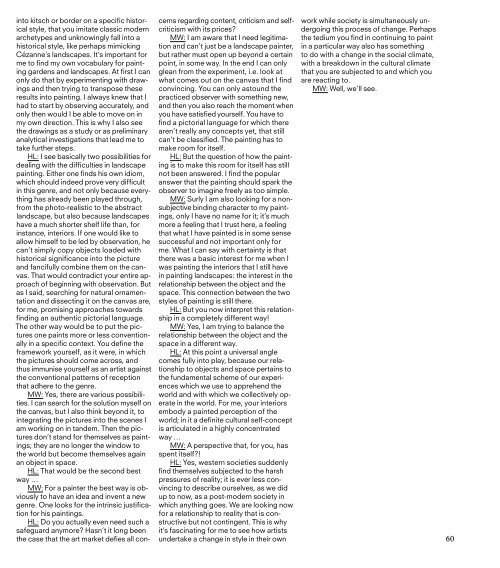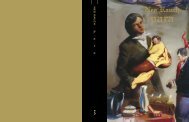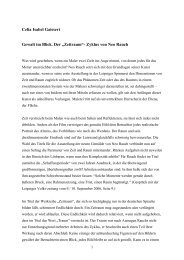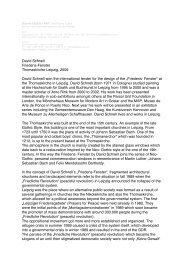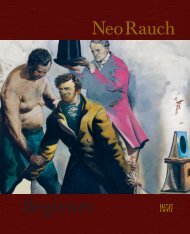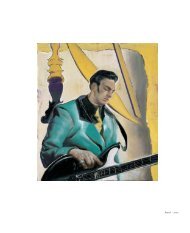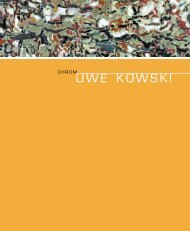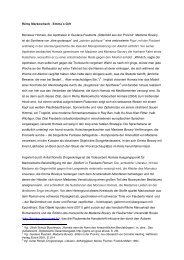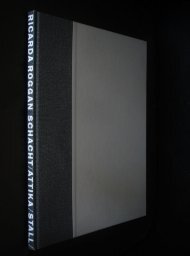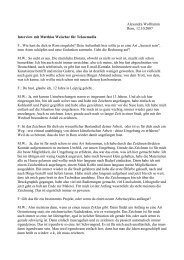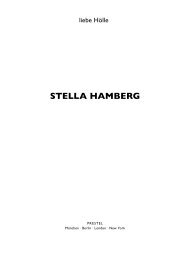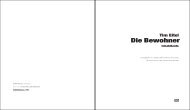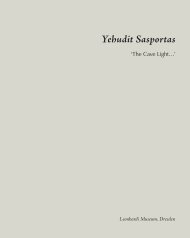Erfolgreiche ePaper selbst erstellen
Machen Sie aus Ihren PDF Publikationen ein blätterbares Flipbook mit unserer einzigartigen Google optimierten e-Paper Software.
into kitsch or border on a specific historical<br />
style, that you imitate classic modern<br />
archetypes and unknowingly fall into a<br />
historical style, like perhaps mimicking<br />
Cézanne’s landscapes. It’s important for<br />
me to find my own vocabulary for painting<br />
gardens and landscapes. At first I can<br />
only do that by experimenting with drawings<br />
and then trying to transpose these<br />
results into painting. I always knew that I<br />
had to start by observing accurately, and<br />
only then would I be able to move on in<br />
my own direction. This is why I also see<br />
the drawings as a study or as preliminary<br />
analytical investigations that lead me to<br />
take further steps.<br />
HL: I see basically two possibilities for<br />
dealing with the difficulties in landscape<br />
painting. Either one finds his own idiom,<br />
which should indeed prove very difficult<br />
in this genre, and not only because everything<br />
has already been played through,<br />
from the photo-realistic to the abstract<br />
landscape, but also because landscapes<br />
have a much shorter shelf life than, for<br />
instance, interiors. If one would like to<br />
allow himself to be led by observation, he<br />
can’t simply copy objects loaded with<br />
historical significance into the picture<br />
and fancifully combine them on the canvas.<br />
That would contradict your entire approach<br />
of beginning with observation. But<br />
as I said, searching for natural ornamentation<br />
and dissecting it on the canvas are,<br />
for me, promising approaches towards<br />
finding an authentic pictorial language.<br />
The other way would be to put the pictures<br />
one paints more or less conventionally<br />
in a specific context. You define the<br />
framework yourself, as it were, in which<br />
the pictures should come across, and<br />
thus immunise yourself as an artist against<br />
the conventional patterns of reception<br />
that adhere to the genre.<br />
MW: Yes, there are various possibilities.<br />
I can search for the solution myself on<br />
the canvas, but I also think beyond it, to<br />
integrating the pictures into the scenes I<br />
am working on in tandem. Then the pictures<br />
don’t stand for themselves as paintings;<br />
they are no longer the window to<br />
the world but become themselves again<br />
an object in space.<br />
HL: That would be the second best<br />
way …<br />
MW: For a painter the best way is obviously<br />
to have an idea and invent a new<br />
genre. One looks for the intrinsic justification<br />
for his paintings.<br />
HL: Do you actually even need such a<br />
safeguard anymore? Hasn’t it long been<br />
the case that the art market defies all con-<br />
cerns regarding content, criticism and selfcriticism<br />
with its prices?<br />
MW: I am aware that I need legitimation<br />
and can’t just be a landscape painter,<br />
but rather must open up beyond a certain<br />
point, in some way. In the end I can only<br />
glean from the experiment, i.e. look at<br />
what comes out on the canvas that I find<br />
convincing. You can only astound the<br />
practiced observer with something new,<br />
and then you also reach the moment when<br />
you have satisfied yourself. You have to<br />
find a pictorial language for which there<br />
aren’t really any concepts yet, that still<br />
can’t be classified. The painting has to<br />
make room for itself.<br />
HL: But the question of how the painting<br />
is to make this room for itself has still<br />
not been answered. I find the popular<br />
answer that the painting should spark the<br />
observer to imagine freely as too simple.<br />
MW: Surly I am also looking for a nonsubjective<br />
binding character to my paintings,<br />
only I have no name for it; it’s much<br />
more a feeling that I trust here, a feeling<br />
that what I have painted is in some sense<br />
successful and not important only for<br />
me. What I can say with certainty is that<br />
there was a basic interest for me when I<br />
was painting the interiors that I still have<br />
in painting landscapes: the interest in the<br />
relationship between the object and the<br />
space. This connection between the two<br />
styles of painting is still there.<br />
HL: But you now interpret this relationship<br />
in a completely different way!<br />
MW: Yes, I am trying to balance the<br />
relationship between the object and the<br />
space in a different way.<br />
HL: At this point a universal angle<br />
comes fully into play, because our relationship<br />
to objects and space pertains to<br />
the fundamental scheme of our experiences<br />
which we use to apprehend the<br />
world and with which we collectively operate<br />
in the world. For me, your interiors<br />
embody a painted perception of the<br />
world; in it a definite cultural self-concept<br />
is articulated in a highly concentrated<br />
way …<br />
MW: A perspective that, for you, has<br />
spent itself?!<br />
HL: Yes, western societies suddenly<br />
find themselves subjected to the harsh<br />
pressures of reality; it is ever less convincing<br />
to describe ourselves, as we did<br />
up to now, as a post-modern society in<br />
which anything goes. We are looking now<br />
for a relationship to reality that is constructive<br />
but not contingent. This is why<br />
it’s fascinating for me to see how artists<br />
undertake a change in style in their own<br />
work while society is simultaneously undergoing<br />
this process of change. Perhaps<br />
the tedium you find in continuing to paint<br />
in a particular way also has something<br />
to do with a change in the social climate,<br />
with a breakdown in the cultural climate<br />
that you are subjected to and which you<br />
are reacting to.<br />
MW: Well, we’ll see.<br />
60<br />
Gartenstudie I<br />
2008<br />
Óleo sobre lienzo /<br />
Oil on canvas<br />
50 × 60 cm


